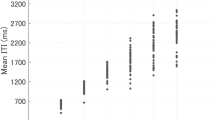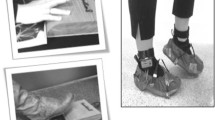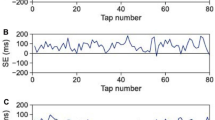Abstract
Finger-tapping tasks have been widely adopted to investigate auditory-motor synchronization, i.e., the coupling of movement with an external auditory rhythm. However, the discrete nature of these movements usually limits their application to the study of beat perception in the context of isochronous rhythms. The purpose of the present pilot study was to test an innovative task that allows investigating bodily responses to complex, non-isochronous rhythms. A conductor’s baton was provided to 16 healthy subjects, divided into 2 different groups depending on the years of musical training they had received (musicians or non-musicians). Ad hoc-created melodies, including notes of different durations, were played to the subjects. Each subject was asked to move the baton up and down according to the changes in pitch contour. Software for video analysis and modelling (Tracker®) was used to track the movement of the baton tip. The main parameters used for the analysis were the velocity peaks in the vertical axis. In the musician group, the number of velocity peaks exactly matched the number of notes, while in the non-musician group, the number of velocity peaks exceeded the number of notes. An exploratory data analysis using Poincaré plots suggested a greater degree of coupling between hand–arm movements and melody in musicians both with isochronous and non-isochronous rhythms. The calculated root mean square error (RMSE) between the note onset times and the velocity peaks, and the analysis of the distribution of velocity peaks in relationship to note onset times confirmed the effect of musical training. Notwithstanding the small number of participants, these results suggest that this novel behavioural task could be used to investigate auditory-motor coupling in the context of music in an ecologically valid setting. Furthermore, the task may be used for rhythm training and rehabilitation in neurological patients with movement disorders.





Similar content being viewed by others
Data availability
Data and material are available on request.
References
Abbruzzese G, Berardelli A (2003) Sensorimotor integration in movement disorders. Mov Disord 18:231–240
Amelynck D, Maes PJ, Martens JP, Leman M (2014) Expressive body movement responses to music are coherent, consistent, and low dimensional. IEEE Trans Cybern. https://doi.org/10.1109/TCYB.2014.2305998
Bangert M, Peschel T, Schlaug G et al (2006) Shared networks for auditory and motor processing in professional pianists: evidence from fMRI conjunction. Neuroimage 30(3):917–926
Bengtsson SL, Ullén F, Ehrsson HH et al (2009) Listening to rhythms activates motor and premotor cortices. Cortex 45(1):62–71
Braun N, Debener S, Spychala N, Bongartz E, Sörös P, Müller HHO, Philipsen A (2018) The senses of agency and ownership: a review. Front Psychol 16(9):535
Brown D, Cox AJ (2009) Innovative Uses of Video Analysis. Phys Teach 47(3):145–150
Buhusi CV, Meck WH (2005) What makes us tick? Functional and neural mechanisms of interval timing. Nat Rev Neurosci 6(10):755–765
Chen H-Y, Wing AM, Pratt D (2006) The synchronisation of lower limb responses with a variable metronome: the effect of biomechanical constraints on timing. Gait Posture 23(3):307–314
Clayton M, Sager R, Will U (2005) In time with the music: the concept of entrainment and its significance for ethnomusicology. Eur Meet Ethnomusicol 11:3–142
Conover WJ (1999) Practical nonparametric statistics, 3rd edn. John Wiley & Sons, New York
Conte A, Belvisi D, Tartaglia M, Cortese FN, Baione V, Battista E, Zhu XY, Fabbrini G, Berardelli A (2017) Abnormal temporal coupling of tactile perception and motor action in Parkinson’s disease. Front Neurol 6(8):249
Doelling KB, Poeppel D (2015) Cortical entrainment to music and its modulation by expertise. Pro Nat Acad Sci 112(45):E6233–E6242
Fischinger T (2013). Timing and synchronisation of professional musicians: a comparison between orchestral brass and string players. Conference Abstract: 14th rhythm production and perception workshop Birmingham 11–13th September 2013
Fujii S, Schlaug G (2013) The harvard beat assessment test (H-BAT): a battery for assessing beat perception and production and their dissociation. Front Hum Neurosci 7:771
Godøy RI (2010) Gestural affordances of musical sound. Taylor and Francis Group, Musical Gestures
Godøy RI and Leman M (2010). Musical gestures: sound, movement, and meaning (Paperback): Routledge. https://doi.org/10.4324/9780203863411
Janzen TB, Haase M, Thaut MH (2019) Rhythmic priming across effector systems: a randomized controlled trial with Parkinson’s disease patients. Hum Mov Sci 64:355–365
Jäncke L (2012) The dynamic audio-motor system in pianists. Ann N Y Acad Sci 1252:246–252
Jones MR, Moynihan H, MacKenzie N, Puente J (2002) Temporal aspects of stimulus-driven attending in dynamic arrays. Psychol Sci 13(4):313–319
Kalckert A, Ehrsson HH (2012) Moving a rubber hand that feels like your own: a dissociation of ownership and agency. Front Hum Neurosci 6:40
Kansaku K, Hanakawa T, Hallett M (2004) A shared neural network for simple reaction time. Neuroimage 22(2):904–911
Kawato M (1999) Internal models for motor controls and trajectory planning. Curr Opin Neurobiol 9(6):718–727
Keller PE (2008). Joint action in music performance. In: Enacting intersubjectivity: a cognitive and social perspective on the study of interactions. Amsterdam, Netherlands: IOS Press 2008 205–21
Kisilevsky S, Hains SMJ, Jacquet AY, Granier-Deferre C, Lecanuet JP (2004a) Maturation of fetal responses to music (2004) Dev. Sci 7(5):550–559
Kisilevsky S, Hains SM, Jacquet AY, Granier-Deferre C, Lecanuet JP (2004b) Maturation of fetal responses to music. Dev Sci 7(5):550–559
Komeilipoor N, Rodger MWM, Craig CM, Cesari P (2015) (Dis-)Harmony in movement: effects of musical dissonance on movement timing and form. Exp Brain Res 233(5):1585–1595
Krause V, Pollok B, Schnitzler A (2010) Perception in action: the impact of sensory information on sensorimotor synchronization in musicians and non-musicians. Acta Psychol (Amst) 133(1):28–37
Lagarde J, Kelso aS J (2006) Binding of movement, sound and touch: multimodal coordination dynamics. Exp Brain Res 173(4):673–688
Leman M (2008) Embodied music cognition and mediation technology. (MIT Press 2008). https://doi.org/10.7551/mitpress/7476.001.0001
Leman M, Maes P-J (2015) The role of embodiment in the perception of music. Empir Musicol Rev 9(3–4):236–246
Leman M, Nijs L, Di Stefano N (2017) On the role of the hand in the expression of music. In: Bertolaso M, Di Stefano N (eds) The Hand. Springer, Cham, pp 175–192
Leman M, Maes PJ, Nijs L, Van Dyck E (2018) What Is Embodied Music Cognition?. In: Bader R (eds) Springer Handbook of Systematic Musicology Springer Handbooks. Springer, Berlin, Heidelberg
Lewis PA, Miall RC (2003) Distinct systems for automatic and cognitively controlled time measurement: evidence from neuroimaging. Curr Opin Neurobiol 13(2):250–255
Longo MR, Schüür F, Kammers MP, Tsakiris M, Haggard P (2008) What is embodiment? Psychom Approach Cognit 107(3):978–998
Luck G, Toiviainen P, Thompson MR (2010) Perception of expression in conductors’ gestures: a continuous response study. Music Percept 28(1):47–57
Maes PJ, Leman M, Palmer C, Wanderley M (2014) Action-based effects on music perception. Front Psychol 4:1008
Margulis EH (2005) A model of melodic expectation. Music Percept Interdiscip J 22(4):663–714
Moore GP (1992) Piano Trills. Music Percept Interdiscip J 9(3):351–359
Moumdjian L, Buhmann J, Willems I, Feys P, Leman M (2018) Entrainment and synchronization to auditory stimuli during walking in healthy and neurological populations: a methodological systematic review. Front Hum Neurosci 12:263
Münte TF, Altenmüller E, Jäncke L (2002) The musician’s brain as a model of neuroplasticity. Nat Rev Neurosci 3(6):473–478
Musicality HS (2006) In: The child as musician: A handbook of musical development. Oxford University Press, New York, NY, US, pp 93–110
Novembre G, Keller PE (2014) A conceptual view on action-perception coupling in the musicians’ brain: what is it good for? Front Human Neurosci 8:603
Phillips-Silver J, Trainor LJ (2005a) Feeling the beat: movement influences infant rhythm perception. Science 308(5727):1430
Phillips-Silver J, Trainor LJ (2005b) Feeling the beat: movement influences infant rhythm perception. Science 308:1430–1430
Phillips-Silver J, Trainor LJ (2007) Hearing what the body feels: auditory encoding of rhythmic movement. Cognition 105(3):533–546
Pinardi M, Ferrari F, D’Alonzo M, Clemente F, Raiano L, Cipriani C, Di Pino G (2020) Doublecheck: a sensory confirmation is required to own a robotic hand, sending a command to feel in charge of it. In press, Cognitive Neuroscience
Pruitt TA, Halpern AR, Pfordresher PQ (2019) Covert singing in anticipatory auditory imagery. Psychophysiology 56:e13297
Repp BH (2005) Sensorimotor synchronization: a review of the tapping literature. Psychon Bull Rev 12(6):969–992
Repp BH (2006) Musical synchronization. In: Music, motor control and the brain. New York, NY, US: Oxford University Press 55–76
Repp BH (2008) Metrical subdivision results in subjective slowing of the beat. Music Percept 26(1):19–39
Repp BH (2010) Sensorimotor synchronization and perception of timing: effects of music training and task experience. Hum Mov Sci 29(2):200–213
Repp BH, Doggett R (2007) Tapping to a very slow beat: a comparison of musicians and nonmusicians. Music Percept 24(4):367–376
Repp BH, Su Y-H (2013) Sensorimotor synchronization: a review of recent research (2006–2012). Psychon Bull Rev 20(3):403–452
Ross JM, Iversen JR, Balasubramaniam R (2016) Motor simulation theories of musical beat perception. Neurocase 22(6):558–565
Shadmehr R, Krakauer JW (2008) A computational neuroanatomy for Motor Control. Exp Brain Res 185(3):359–381
Studenka BE, Zelaznik HN (2011) Circle drawing does not exhibit auditory-motor synchronization. J Mot Behav 43(3):185–191
Styns F, van Noorden L, Moelants D, Leman M (2007) Walking on music. Hum Mov Sci 26(5):769–785
Synofzik M, Vosgerau G, Newen A (2008) I move, therefore I am: a new theoretical framework to investigate agency and ownership. Conscious Cogn 17(2):411–424
Toiviainen P, Luck G, Thompson MR (2010) Embodied meter: hierarchical eigenmodes in music-induced movement. Music Percept Interdiscipl J 28(1):59–70
Trainor LJ (2008) The neural roots of music. Nature 453:598–599
Tryfon A, Foster NE, Ouimet T et al (2017) Auditory-motor rhythm synchronization in children with autism spectrum disorder. Res Autism Spectr Disord 35:51–61
Tsakiris M, Schütz-Bosbach S, Gallagher S (2007) On agency and body-ownership: phenomenological and neurocognitive reflections. Conscious Cogn 16(3):645–660
von Hippel P (2002). Melodic-expectation rules as learned heuristics. In Proceedings of the 7th International Conference on Music Perception and Cognition, Sydney
Zangrandi A, Mioli A, D’Alonzo M, Formica D, Pellegrino G, Di Pino G (2019) Conditioning transcranial magnetic stimulation of ventral premotor cortex shortens simple reaction time. Cortex 121:322–331
Zatorre RJ, Chen JL, Penhune VB (2007) When the brain plays music: auditory-motor interactions in music perception and production. Nat Rev Neurosci 8(7):547–558
Zendel BR, Ross B, Fujioka T (2011) The effects of stimulus rate and tapping rate on tapping performance. Music Percept 29(1):65–78
Acknowledgements
We would like to thank the Linear® s.r.l. for the precious help with this study. We also thank Roberto Lupo for his support during the study design.
Funding
This work was partially funded by the H2020/ICT European project CONBOTS (“CONnected through roBOTS: physically coupling humans to boost handwriting and music learning”, Grant Agreement no. 871803, call topic ICT-09-2019-2020).
Author information
Authors and Affiliations
Contributions
AC: study design, data collection and analysis, manuscript development, review of final manuscript. NDS: study design, review of final manuscript. FT: data analysis, review of final manuscript. GDP: manuscript development, review of final manuscript. MC: study design, review of final manuscript. FK: study design, music composition, data analysis, manuscript development, review of final manuscript.
Corresponding authors
Ethics declarations
Conflict of interest
All authors certify that they have no affiliations with or involvement in any organization or entity with any financial interest (such as honoraria; educational grants; participation in speakers’ bureaus; membership, employment, consultancies, stock ownership, or other equity interest; and expert testimony or patent-licensing arrangements), or non-financial interest (such as personal or professional relationships, affiliations, knowledge or beliefs) in the subject matter or materials discussed in this manuscript.
Ethics approval
The study was approved by the Ethical Committee of University Campus Bio-Medico (Prot: 11.19 TS ComEt-CBM 08/2019).
Consent to participate
Informed consent was obtained from all participants before including them in the study.
Consent for publication
Consent for the publication of this study was obtained from both participants and the Ethical Committee of University Campus Bio-Medico.
Additional information
Communicated by Francesco Lacquaniti.
Publisher's Note
Springer Nature remains neutral with regard to jurisdictional claims in published maps and institutional affiliations.
Rights and permissions
About this article
Cite this article
Costantino, A., Di Stefano, N., Taffoni, F. et al. Embodying melody through a conducting baton: a pilot comparison between musicians and non-musicians. Exp Brain Res 238, 2279–2291 (2020). https://doi.org/10.1007/s00221-020-05890-z
Received:
Accepted:
Published:
Issue Date:
DOI: https://doi.org/10.1007/s00221-020-05890-z




